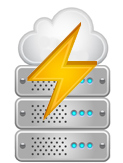[fusion_text]
You can’t predict when your offices will experience an event such as a power failure or a bigger disaster, such as flooding, however you can protect it to minimize the damages that can occur as a result of such a situation.
Many companies rely on their Accounting ERP software on a daily basis for managing their business, and any time without access to it can result in loss of sales, loss of income and loss of ongoing business. Having a disaster recovery plan (which does not have to be complex or costly) can mitigate the damages caused by downtime. Yet many small to mid size businesses do not have such a plan in place.
While a full blown plan should start with a risk assessment, followed by complete documentation of procedures and steps to follow, the key components of a basic plan include immediate backup power, data backups and facilities from which to access the data.
Immediate Backup Power
It is critical that servers hosting key data, a workstation and a printer all have an un-interruptable power supply (UPS). In the case of a power failure, depending on the power of the UPS this should give a minimum of 20 – 30 minutes of time to save documents, complete transactions which are in the middle of being processed, download any spreadsheets or other documents onto portable storage and print any key documents which will be needed. If using a laptop, as long as the batteries are charged this acts as a built in UPS.
Backups
In today’s day and age many companies are already ahead of the game by virtue of having a SaaS vs. on-premises installation of their accounting ERP software. A respectable hosted software solution provider will be creating backups of their customer’s data on a regular basis, and have backup generators, making the system available even if the power is out for an extended period of time. For those with an on-premises ERP implementation, it is good practice to have backups of the database made on a regular basis. Ideally these backups should be stored offsite (in case of physical damage to, or inaccessibility of the offices) and should be accessible on short notice.
Facilities from Which to Access Data
Not too long ago having access to an offsite location known as a “Hot Site” which had furniture, phones computers and access to the company database was the primary way to get back on-line after some event restricting the use of the main system in the office. This was often a major expense only undertaken by larger companies with big budgets. Today in many circumstances all that is required is a computer (laptop or desktop) with an internet connection. This can be in an employee’s house or even a local coffee shop (although printing might be more difficult there)! While this option would always be possible with a SaaS vs. on-premises installation of your software, there are circumstances under which you would be able to access your software in an on-premises installation as well.
Depending on the type of business you are running, you may or may not be able to be fully operational without access to your physical premises, however having the above mentioned items in place and a plan to make use of them in an emergency situation will give you a start. With proper procedures in place, communicating with customers and suppliers to inform them of your situation, making collections calls, drop shipping from your vendors to your customers and in certain circumstances even shipping from your warehouse could be accomplished.
[/fusion_text]











